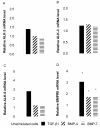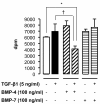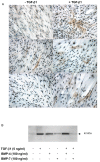Bone morphogenetic protein (BMP)-4 and BMP-7 regulate differentially transforming growth factor (TGF)-beta1 in normal human lung fibroblasts (NHLF)
- PMID: 20573231
- PMCID: PMC2898775
- DOI: 10.1186/1465-9921-11-85
Bone morphogenetic protein (BMP)-4 and BMP-7 regulate differentially transforming growth factor (TGF)-beta1 in normal human lung fibroblasts (NHLF)
Abstract
Background: Airway remodelling is thought to be under the control of a complex group of molecules belonging to the transforming growth factor (TGF)-superfamily. The bone morphogenetic proteins (BMPs) belong to this family and have been shown to regulate fibrosis in kidney and liver diseases. However, the role of BMPs in lung remodelling remains unclear. BMPs may regulate tissue remodelling in asthma by controlling TGF-beta-induced profibrotic functions in lung fibroblasts.
Methods: Cell cultures were exposed to TGF-beta1 alone or in the presence of BMP-4 or BMP-7; control cultures were exposed to medium only. Cell proliferation was assessed by quantification of the incorporation of [3H]-thymidine. The expression of the mRNA encoding collagen type I and IV, tenascin C and fibronectin in normal human lung fibroblasts (NHLF) was determined by real-time quantitative PCR and the main results were confirmed by ELISA. Cell differentiation was determined by the analysis of the expression of alpha-smooth muscle actin (alpha-SMA) by western blot and immunohistochemistry. The effect on matrix metalloproteinase (MMP) activity was assessed by zymography.
Results: We have demonstrated TGF-beta1 induced upregulation of mRNAs encoding the extracellular matrix proteins, tenascin C, fibronectin and collagen type I and IV when compared to unstimulated NHLF, and confirmed these results at the protein level. BMP-4, but not BMP-7, reduced TGF-beta1-induced extracellular matrix protein production. TGF-beta1 induced an increase in the activity of the pro-form of MMP-2 which was inhibited by BMP-7 but not BMP-4. Both BMP-4 and BMP-7 downregulated TGF-beta1-induced MMP-13 release compared to untreated and TGF-beta1-treated cells. TGF-beta1 also induced a myofibroblast-like transformation which was partially inhibited by BMP-7 but not BMP-4.
Conclusions: Our study suggests that some regulatory properties of BMP-7 may be tissue or cell type specific and unveil a potential regulatory role for BMP-4 in the regulation of lung fibroblast function.
Figures







Similar articles
-
Interleukin-1α inhibits transforming growth factor-β1 and β2-induced extracellular matrix production, remodeling and signaling in human lung fibroblasts: Master regulator in lung mucosal repair.Matrix Biol. 2024 Sep;132:47-58. doi: 10.1016/j.matbio.2024.06.007. Epub 2024 Jul 4. Matrix Biol. 2024. PMID: 39147560
-
The mannose-6-phosphate analogue, PXS64, inhibits fibrosis via TGF-β1 pathway in human lung fibroblasts.Immunol Lett. 2015 Jun;165(2):90-101. doi: 10.1016/j.imlet.2015.04.003. Epub 2015 Apr 27. Immunol Lett. 2015. PMID: 25929803
-
Reversal of TGF-β1 stimulation of α-smooth muscle actin and extracellular matrix components by cyclic AMP in Dupuytren's-derived fibroblasts.BMC Musculoskelet Disord. 2011 May 25;12:113. doi: 10.1186/1471-2474-12-113. BMC Musculoskelet Disord. 2011. PMID: 21612641 Free PMC article.
-
Bone morphogenetic protein-7 modulates genes that maintain the vascular smooth muscle cell phenotype in culture.J Bone Joint Surg Am. 2001;83-A Suppl 1(Pt 1):S70-8. J Bone Joint Surg Am. 2001. PMID: 11263669 Review.
-
Tenascin-C: Form versus function.Cell Adh Migr. 2015;9(1-2):48-82. doi: 10.4161/19336918.2014.987587. Cell Adh Migr. 2015. PMID: 25482829 Free PMC article. Review.
Cited by
-
BMP-7 Attenuates TGF-β1-Induced Fibronectin Secretion and Apoptosis of NRK-52E Cells by the Suppression of miRNA-21.Oncol Res. 2016;23(4):147-54. doi: 10.3727/096504016X14519157902645. Oncol Res. 2016. PMID: 27053343 Free PMC article.
-
Emerging role of BMPs/BMPR2 signaling pathway in treatment for pulmonary fibrosis.Biomed Pharmacother. 2024 Sep;178:117178. doi: 10.1016/j.biopha.2024.117178. Epub 2024 Aug 13. Biomed Pharmacother. 2024. PMID: 39142248 Free PMC article. Review.
-
Periostin-expressing cell-specific transforming growth factor-β inhibition in pulmonary artery prevents pulmonary arterial hypertension.PLoS One. 2019 Aug 22;14(8):e0220795. doi: 10.1371/journal.pone.0220795. eCollection 2019. PLoS One. 2019. PMID: 31437169 Free PMC article.
-
Dedicator of Cytokinesis 2 (DOCK2) Deficiency Attenuates Lung Injury Associated with Chronic High-Fat and High-Fructose Diet-Induced Obesity.Am J Pathol. 2022 Feb;192(2):226-238. doi: 10.1016/j.ajpath.2021.10.011. Epub 2021 Nov 10. Am J Pathol. 2022. PMID: 34767813 Free PMC article.
-
Tenascin-C: Friend or Foe in Lung Aging?Front Physiol. 2021 Oct 27;12:749776. doi: 10.3389/fphys.2021.749776. eCollection 2021. Front Physiol. 2021. PMID: 34777012 Free PMC article.
References
-
- Bousquet J, Jeffery PK, Busse WW, Johnson M, Vignola AM. Asthma. From bronchoconstriction to airways inflammation and remodeling. Am J Respir Crit Care Med. 2000;161(5):1720–1745. - PubMed
Publication types
MeSH terms
Substances
Grants and funding
LinkOut - more resources
Full Text Sources
Other Literature Sources
Miscellaneous

